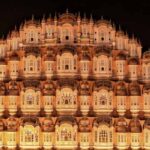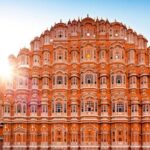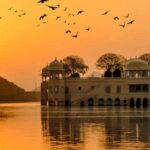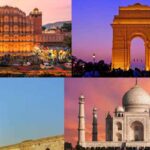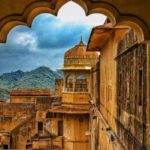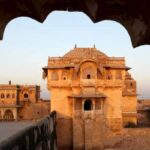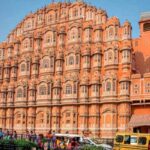Top 10 Tourist Spots In Jaipur, the vibrant capital city of Rajasthan in India, is renowned for its rich history, stunning architecture, and vibrant culture. This city, also known as the “Pink City” due to the color of its buildings, offers a plethora of tourist spots that showcase its regal heritage and charm.
The majestic Amer Fort stands as a crown jewel, located atop a hill overlooking the city. Its impressive architecture, intricate carvings, and expansive courtyards reflect the opulence of the Rajput era. Nearby, the Jaigarh Fort offers panoramic views of the surroundings and houses the world’s largest cannon on wheels, Jaivana.
Hawa Mahal, or the “Palace of Winds,” is an iconic structure with its unique honeycomb-like facade, allowing royal women to observe street festivities while remaining unseen. The City Palace, a magnificent complex blending Rajasthani and Mughal architecture, encompasses museums, courtyards, and gardens, offering a glimpse into Jaipur’s royal history.
Jantar Mantar, an astronomical observatory built by Maharaja Sawai Jai Singh II, showcases a collection of architectural astronomical instruments. Each instrument serves a specific purpose and demonstrates ancient astronomical expertise Jaipur Tour Packages.
Nahargarh Fort, situated on the Aravalli hills, provides breathtaking views of the city and is a popular spot to witness stunning sunsets. Additionally, the Albert Hall Museum, with its Indo-Saracenic architecture, houses a diverse collection of artifacts and exhibits depicting Rajasthan’s history and culture.
Jaipur is also famous for its bustling local markets like Johari Bazaar and Bapu Bazaar, offering traditional handicrafts, textiles, jewelry, and more.
The vibrant culture, magnificent palaces, forts, and bustling markets make Jaipur Tourism a must-visit destination for travelers seeking a glimpse into Rajasthan’s royal past and rich heritage.
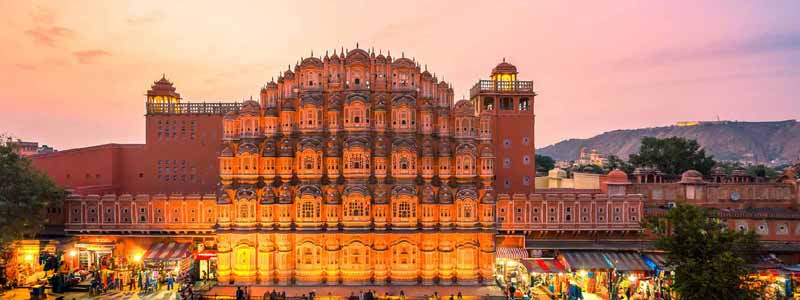
Hawa Mahal (Palace of Winds)
Hawa Mahal, or the “Palace of Winds,” stands as an iconic and captivating structure in the heart of Jaipur, Rajasthan. Built-in 1799 by Maharaja Sawai Pratap Singh, this architectural marvel is an integral part of the city’s heritage and history.
The five-story palace, constructed of red and pink sandstone, is renowned for its unique facade adorned with 953 intricately designed windows known as jharokhas. These windows were crafted to allow royal women to observe street processions, daily life, and festivities while remaining veiled from public view. The lattice work on the windows also facilitated cool air circulation, providing a respite from the scorching desert heat—a reason behind its name, Hawa Mahal, which translates to the “Palace of Winds.”
The design of Hawa Mahal is inspired by the crown of Lord Krishna and resembles the shape of a honeycomb. The palace’s architecture reflects a fusion of Rajput and Mughal styles, featuring intricate carvings, domes, and ornate detailing, making it a visual delight for visitors Jaipur Day Tours.
While the exterior is the most iconic aspect, the interior of Hawa Mahal consists of small rooms, passages, and corridors leading to the upper floors. Visitors can explore the museum inside the palace, showcasing artifacts, paintings, and historical items, shedding light on Jaipur’s royal past and lifestyle.
Hawa Mahal’s grandeur and architectural uniqueness make it a must-visit destination in Jaipur, offering a glimpse into the opulent heritage of Rajasthan and serving as a testament to the city’s rich cultural legacy.
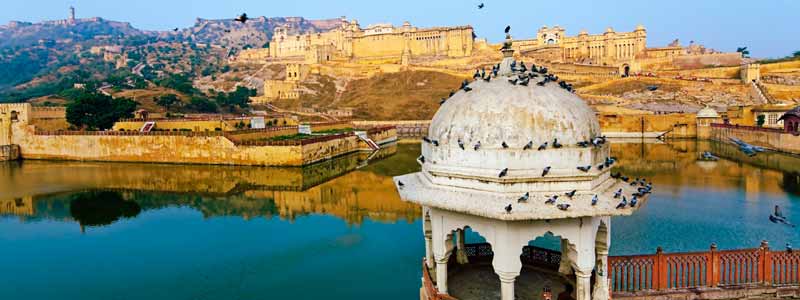
Amber Fort (Amer Fort)
The Amber Fort, also known as Amer Fort, is an architectural marvel situated on a hilltop overlooking Maota Lake, about 11 kilometers from Jaipur, Rajasthan, India. This majestic fort stands as a testament to the royal heritage and architectural brilliance of the Rajputana era.
Constructed in the 16th century by Raja Man Singh I, the fort’s sturdy walls, intricate carvings, and grand courtyards reflect a fusion of Rajput and Mughal architectural styles. The fort’s main entrance, Suraj Pol (Sun Gate), leads to a cobbled pathway adorned with intricate designs and frescoes, creating a grand entrance to this historic marvel.
One of the highlights of Amber Fort is the Diwan-i-Aam (Hall of Public Audience), where the king addressed the public and conducted meetings. The Sheesh Mahal (Mirror Palace) is a breathtaking chamber entirely embellished with tiny, intricate mirror work that reflects even the faintest ray of light, creating a mesmerizing effect.
The Ganesh Pol, an ornately decorated gateway, leads to the private quarters of the royal family. The Sukh Niwas (Hall of Pleasure), with its unique cooling system of water cascading through channels, showcases the ingenuity of ancient engineering to combat the desert heat.
Tourists often enjoy an elephant ride, adding to the regal experience while ascending the fort. The Sound and Light Show held in the evening narrates the fort’s history, adding an enchanting allure to the visit.
The Amber Fort stands as a living testament to Jaipur’s rich history, architectural grandeur, and the opulent lifestyle of Rajasthan’s erstwhile royalty, attracting visitors from around the world to marvel at its beauty and splendor.
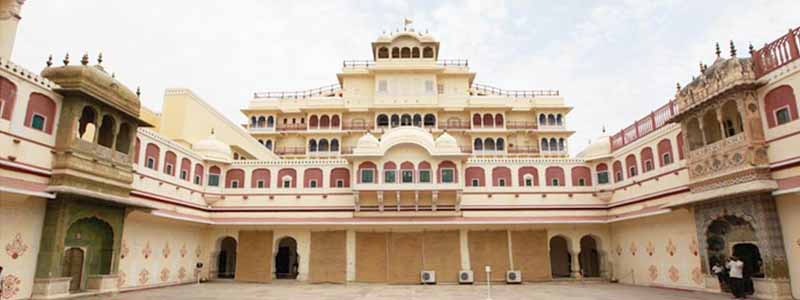
City Palace
The City Palace in Jaipur, Rajasthan, stands as a magnificent testament to the city’s royal heritage and architectural grandeur. Built in the 18th century by Maharaja Sawai Jai Singh II, the City Palace is a splendid complex that beautifully combines Rajput, Mughal, and European architectural styles.
Sprawling across a vast area, the palace complex comprises a series of courtyards, gardens, buildings, and palatial structures. It remains the residence of the royal family of Jaipur, although a significant part of it has been converted into museums and exhibits open to the public.
The intricate detailing, ornate decorations, and stunning craftsmanship are evident throughout the palace. Each section of the palace showcases a unique blend of artistry, with delicate mirror work, colorful paintings, and intricate lattice designs adorning the walls and ceilings.
The Mubarak Mahal, a part of the palace, now serves as the Textile Museum, displaying a fascinating collection of royal costumes, textiles, and garments worn by the erstwhile rulers. The Chandra Mahal, still used by the royal family, houses a museum where visitors can explore an impressive array of artifacts, paintings, and weaponry from the bygone era.
One of the most captivating features of the City Palace is the Peacock Gate (Pitam Niwas Chowk), adorned with exquisite motifs representing the four seasons. Each gate in this courtyard symbolizes a different Hindu deity, showcasing the intricate craftsmanship and cultural significance prevalent in the palace’s design.
Visiting the City Palace allows tourists to immerse themselves in the opulent history and grandeur of Jaipur’s royal past, offering a captivating glimpse into the lives of the erstwhile rulers and their majestic legacy.
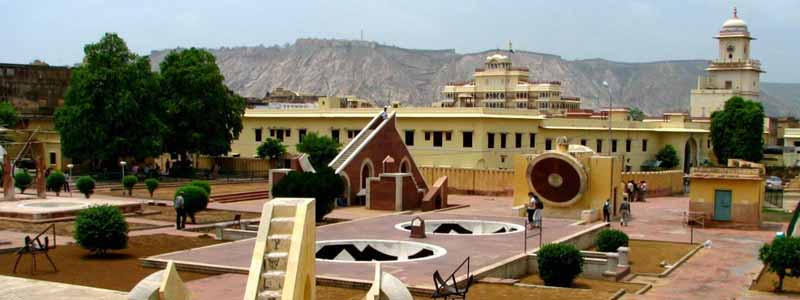
Jantar Mantar
Jantar Mantar in Jaipur is a UNESCO World Heritage Site and an extraordinary astronomical observatory, built by Maharaja Sawai Jai Singh II in the early 18th century. It stands as a testament to the scientific acumen and architectural brilliance of ancient India.
This remarkable site comprises a collection of 19 architectural astronomical instruments, each meticulously constructed to observe celestial bodies’ positions and track time accurately. The instruments are designed based on ancient Indian, Persian, and Greek astronomical principles.
The most striking instrument at Jantar Mantar is the Samrat Yantra, a massive sundial that measures time with exceptional precision. The Samrat Yantra stands at 27 meters tall and can indicate time with an accuracy of about two seconds.
Another notable instrument is the Jai Prakash Yantra, used to measure celestial altitudes and azimuths. It consists of concave hemispherical structures with markings to track the positions of stars and planets.
The Ram Yantra and the Chakra Yantra are other intriguing instruments that aid in measuring the positions of celestial objects and determining various astronomical parameters.
Visitors to Jantar Mantar can explore these fascinating instruments, marvel at their architectural design and understand the scientific principles behind their functioning. The site offers an intriguing blend of history, architecture, and astronomy, showcasing the advanced knowledge and skills possessed by ancient Indian astronomers.
Jantar Mantar in Jaipur serves as a living testimony to India’s rich astronomical heritage and continues to attract tourists, historians, astronomers, and curious minds eager to unravel the mysteries of the cosmos through these ancient yet highly accurate instruments.
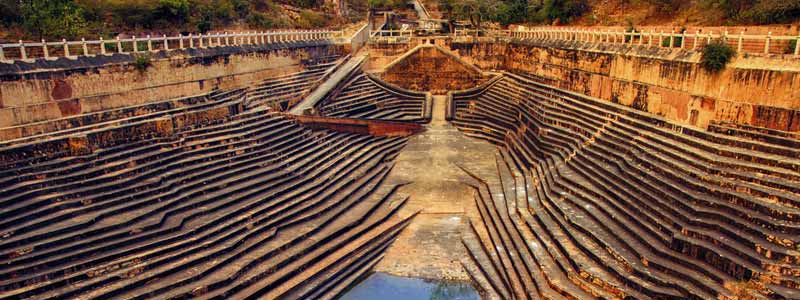
Nahargarh Fort
Nahargarh Fort, perched on the rugged Aravalli hills overlooking the pink city of Jaipur in Rajasthan, India, stands as a magnificent testament to the region’s rich history and architectural brilliance. Built in the 18th century by Maharaja Sawai Jai Singh II, the fort was originally designed as a defense bastion to protect the city.
The name “Nahargarh” translates to “abode of tigers,” with legends suggesting that the fort was named after Nahar Singh, a prince whose spirit was believed to haunt the area and hindered the fort’s construction until appeased. The fort’s robust walls, bastions, and strategically placed cannons bear testimony to its military significance.
Beyond its defensive purpose, Nahargarh Fort offers visitors a captivating experience. The stunning architecture of the fort, characterized by intricate designs, sprawling courtyards, and captivating views of the surrounding landscapes, attracts tourists and history enthusiasts alike.
The fort houses several palatial structures, including Madhavendra Bhawan, a series of interconnected suites built for the royal family, showcasing exquisite frescoes and a unique layout designed for coolness during summers and warmth in winters.
One of the major draws of Nahargarh Fort is the panoramic view it offers of Jaipur city. Visitors can witness breathtaking sunsets, capturing the changing hues of the sky against the backdrop of the bustling city below, making it a popular spot for photographers and tourists seeking memorable vistas.
With its historical significance, architectural beauty, and panoramic views, Nahargarh Fort continues to stand as a prominent attraction in Jaipur, inviting travelers to immerse themselves in the grandeur of Rajasthan’s regal past while enjoying the natural beauty that surrounds it.
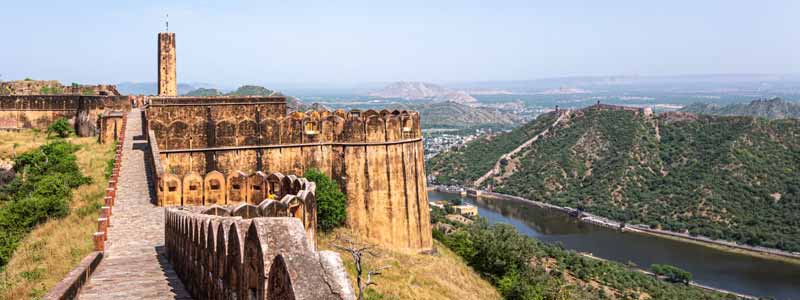
Jaigarh Fort
Jaigarh Fort, perched atop the Aravalli Hills near Jaipur, Rajasthan, stands as a magnificent testament to the region’s rich history and architectural prowess. Built in the 18th century by Maharaja Sawai Jai Singh II, this formidable fortress is often referred to as the “Victory Fort” and is closely associated with the nearby Amer Fort.
The fort was primarily constructed to protect the Amer Fort and the city of Jaipur. Its strategic location provides stunning panoramic views of the surrounding landscape, including Amer Fort and the Maota Lake below. Its sturdy walls, watchtowers, and well-preserved structures showcase the military might and architectural brilliance of its time.
One of the most notable attractions within Jaigarh Fort is the Jaivana Cannon, considered the world’s largest wheeled cannon. Cast in the 18th century, Jaivana remains a remarkable engineering marvel, weighing several tons and showcasing the technological advancement of that era.
The fort also houses various palaces, granaries, reservoirs, and temples within its premises. The water reservoirs, like the huge underground water tanks, highlight the advanced water harvesting and storage systems of the time.
Visitors can explore the armory museum within the fort, displaying an extensive collection of arms, armors, artifacts, and photographs, offering insights into the military history and weaponry of the Rajputs.
The serene ambiance, coupled with historical significance and stunning vistas, makes Jaigarh Fort a compelling destination for history enthusiasts, architecture aficionados, and travelers seeking a glimpse into Rajasthan’s glorious past. Its cultural and historical significance, along with the breathtaking views it offers, make it an integral part of Jaipur’s heritage landscape.
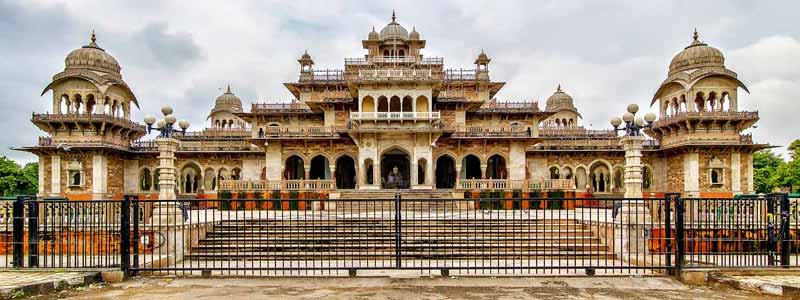
Albert Hall Museum
The Albert Hall Museum, located in Jaipur, Rajasthan, is a splendid example of Indo-Saracenic architecture and stands as a testament to the city’s rich cultural heritage. Commissioned in the late 19th century by Maharaja Sawai Ram Singh II and designed by Sir Samuel Swinton Jacob, this museum was originally intended to be a town hall but was later converted into a museum.
One of the main attractions of the Albert Hall Museum is its stunning architectural design. The building features a fusion of Rajput, Mughal, and European architectural elements, adorned with intricately carved arches, domes, and lattice work. Its grand facade, illuminated beautifully at night, draws visitors to explore the treasures housed within.
Inside, the museum boasts an extensive and diverse collection of artifacts, showcasing Rajasthan’s cultural and historical heritage. The galleries display an array of items including ancient sculptures, exquisite paintings, textiles, arms and armor, pottery, jewelry, and decorative arts. Visitors can marvel at the museum’s rich assortment of artifacts dating back centuries, providing insight into Rajasthan’s art, culture, and history.
The museum also hosts various temporary exhibitions, cultural events, and educational programs, adding vibrancy to its offerings and attracting art enthusiasts, historians, and tourists alike.
Surrounded by lush gardens and illuminated by decorative lighting, the Albert Hall Museum stands as an iconic landmark in Jaipur, inviting visitors to immerse themselves in the grandeur of Rajasthan’s artistic legacy and historical significance.
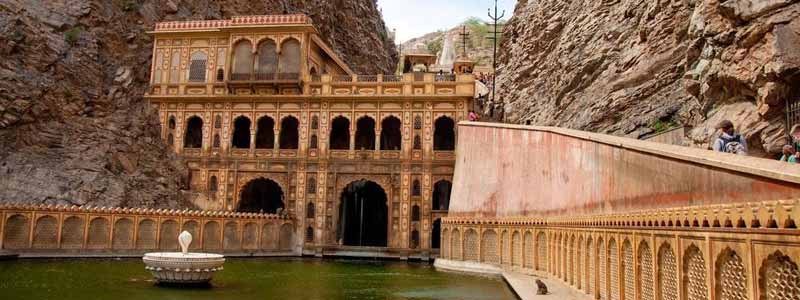
Galta Ji (Monkey Temple)
Galta Ji, commonly known as the Monkey Temple, is a unique and captivating Hindu pilgrimage site located in the outskirts of Jaipur, Rajasthan. Nestled amid the picturesque Aravalli hills, this temple complex holds religious significance and is home to a large troop of monkeys, giving it the name “Monkey Temple.”
The complex comprises several temples, pavilions, and natural freshwater springs. The main temple, dedicated to Lord Hanuman, is adorned with intricate carvings and paintings, reflecting traditional Rajasthani architecture. Visitors are greeted by the sight of numerous macaques that inhabit the surroundings, creating a playful and lively atmosphere.
Galta Ji’s natural springs, known as the Galta Kund, are considered sacred and are fed by a stream flowing through the hills. Devotees and visitors often take ritual baths in these holy waters, believing in their purifying and spiritual properties. The pools are surrounded by stunning rock formations and offer a serene and tranquil ambiance.
The temple complex also houses other shrines dedicated to various Hindu gods and goddesses, contributing to the spiritual aura of the site. The panoramic view from the hills surrounding the temple provides a breathtaking landscape of Jaipur city.
Visiting Galta Ji offers not only a religious and spiritual experience but also a chance to witness the coexistence of nature and faith, with the monkeys adding a unique charm to the entire setting. The serene surroundings and the religious fervor make it a captivating destination for tourists seeking cultural immersion and natural beauty in Jaipur.
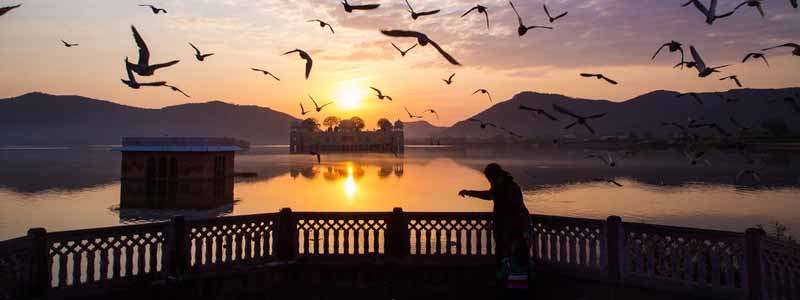
Jal Mahal
Jal Mahal, translating to “Water Palace,” is an architectural marvel situated amidst the Man Sagar Lake in Jaipur, Rajasthan. This stunning palace, an exquisite example of Rajput and Mughal architectural styles, appears to float serenely in the middle of the picturesque lake.
The palace, built during the 18th century by Maharaja Madho Singh I, features a unique blend of red sandstone and intricate Mughal-inspired architecture. While the palace’s lower floors are submerged in the lake’s waters, the upper floors and distinctive domes are visible, creating a mesmerizing sight.
Jal Mahal was initially intended as a summer retreat for the royals, providing respite from the scorching desert heat of Rajasthan. Surrounded by the Aravalli hills and offering a tranquil ambiance, it served as a hunting lodge and entertainment destination for the royal family.
Though visitors cannot access the interior of the palace due to its current state of preservation, the picturesque view of the palace against the backdrop of the Aravalli hills is a sight to behold. The palace illuminates beautifully during the evenings, creating a magical ambiance reflected in the tranquil waters of the lake.
Tourists can appreciate the beauty of Jal Mahal from a distance by visiting the pathways around the Man Sagar Lake, offering breathtaking views of this architectural gem. Boating facilities in the lake allow visitors to enjoy the scenic beauty and capture stunning photographs of the palace against the water and hills.
Jal Mahal stands as a testament to Jaipur’s rich history and architectural prowess, drawing visitors with its captivating beauty and serene surroundings, making it a must-see attraction for anyone exploring the Pink City of Jaipur.
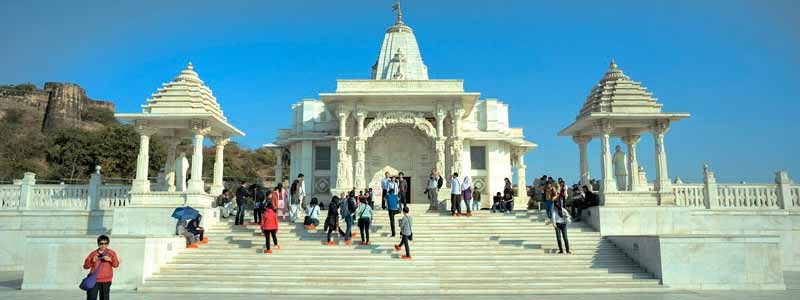
Birla Mandir (Laxmi Narayan Temple)
The Birla Mandir, also known as the Laxmi Narayan Temple, is a significant religious and architectural marvel located in Jaipur, Rajasthan. Built by the renowned Birla family, this temple stands as a symbol of devotion and architectural excellence.
Situated at the base of Moti Dungari Hill, the temple is dedicated to Lord Vishnu and Goddess Laxmi, the Hindu deities of wealth and prosperity. Constructed using pristine white marble, the temple’s exterior radiates a serene glow during the day and emits a mesmerizing aura when illuminated at night.
The intricate carvings on the walls, beautifully sculpted idols, and ornate architecture showcase a blend of traditional and modern influences. The three domes of the temple represent three different approaches to religion, welcoming followers of all faiths.
Inside the temple, visitors are greeted by the idols of Lord Vishnu and Goddess Laxmi adorned with intricate embellishments. The walls are adorned with mythological scenes and teachings from Hindu scriptures, adding to the spiritual ambiance.
The lush landscaped gardens surrounding the temple provide a tranquil space for visitors to relax and meditate. The panoramic view of Jaipur city from the temple premises is breathtaking, offering a serene escape from the bustling urban life.
Throughout the year, various religious festivals and ceremonies are celebrated with great fervor, attracting devotees and tourists alike to partake in the festivities and experience the spiritual essence of the temple.
The Birla Mandir in Jaipur stands not only as a place of worship but also as a testament to exquisite craftsmanship and architectural brilliance, inviting visitors to explore its religious significance and captivating beauty.


